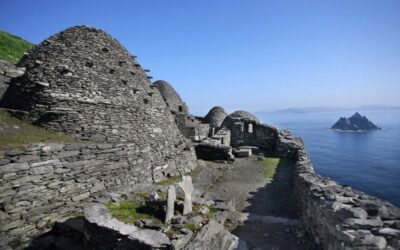We live in a sacramental world.
St. Augustine defined a sacrament as “a visible sign of an invisible grace.” In other words, it is an outward sign using physical objects and actions that points to something God is doing inside of us. Sacraments use the physical to point to deeper spiritual realities, and they convey grace to us in the process.
Though the universe is not a sacrament, it is sacramental because points beyond itself to the invisible and spiritual. We see this in the many passages in Scripture that draw from the natural world to teach spiritual truths.
Some Scriptural Examples
Noah is given the sign of the rainbow as a token of God’s promise not to flood the earth again. Abraham is told to count the stars, if he can, and is promised that his descendants would be as many as the stars in the sky and the grains of sand.
Psalm 1 tells us that the righteous man is like a tree planted by streams of water that yields its fruit in season and whose leaf does not wither, but the wicked are like chaff blown away by the wind. Psalm 19 tells us that the heavens speak of God’s glory. Psalm 36 tells us that God’s righteousness is like the mountains and his judgments like the sea. Other passages speak of living water and the river of life coming from God’s eschatological temple.
Jesus regularly used illustrations from the natural world in his parables. We mustn’t think that Jesus was thinking, “I want to teach this point, but what can I use to illustrate it? Maybe something from agriculture….” No, Jesus was the Word, the Logos, the reason and logic through whom God created the universe. This means that when the universe was created, these things were placed in the world intentionally as metaphors for spiritual truths. Jesus was using what he put here in the first place in His teaching.
In other words, these things are sacramental. They are signs that were created to point beyond themselves to spiritual truth. This is true of the entire creation—it reveals God’s invisible attributes and divine nature (Rom. 1:20).
Reading the Book of Nature
None of this is a new idea. The medieval and early modern church spoke of God’s two books, the Book of Nature and the Book of Scripture. Both are ways God reveals himself to us.
Unfortunately, Christians who seek to be biblically faithful too often miss this. In their zeal for Scripture, they ignore the world as a source of revelation. Ironically, part of the reason for this is the influence of post-Enlightenment rationalism, which claims that the world of fact is totally separate from the world of faith. The net result is that too many of us no longer believe that the physical world can convey grace or speak to us of God.
We have lost the ability to read the Book of Nature.
This is more than an intellectual problem. It affects us spiritually and morally and has contributed to the crisis of meaning in our culture today. And so we desperately need to recover a sacramental vision of the world. This will even help us develop the kind of apologetic I discussed here. The question is, how?
I would suggest a few ways to begin.
Some Suggestions
When we read Scripture, take seriously what it says about the natural world and carry that with you when you in your encounters with nature. When you see a river or a stream, think about what Scripture tells us about living water. Why is that image important? What does water do in the physical world, and what does that suggest the living water promised in the Word does for us? If you are near mountains, what do they tell you about God’s righteousness? Or what does the ocean say about God’s judgments?
In other words, use Scripture to exegete creation, and creation to enrich our understanding of Scripture.
Along with this, take Sherlock Holmes’ rebuke of Watson to heart: “You see but you do not observe.” Train yourself in the habit of genuinely observing the natural world around you. When I am out, my mind can be so occupied with other things that I miss the beauty of the world around me. I see it, but I do not observe it. Disciplining ourselves to pay attention to the environment, to express thanks to God for it, to enjoy its beauty which is itself a shadow of the beauty of its Creator, all will help develop a sacramental vision.
First hand experience is essential, but written and online resources can help in the process. The Symbolic World is a great place to start for further exploration.



Spot on!
I am going to repost this. I have been saying the same thing for years, that Christ spoke the world into existence exactly to teach us Truth. You wrote it so beautifully. I am almost going to add an emoji but I shall refrain. Thanks be to God!